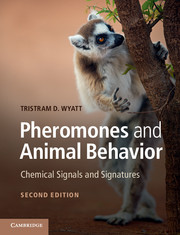Book contents
- Frontmatter
- Dedication
- Contents
- Preface to the second edition
- Acknowledgments
- List of SI prefixes
- List of Abbreviations
- 1 Animals in a chemical world
- 2 Methods for identifying and studying semiochemicals
- 3 Pheromones, chemical cues, and sexual selection
- 4 Coming together and keeping apart: aggregation pheromones and host-marking pheromones
- 5 Territorial behavior and semiochemicals
- 6 Semiochemicals and social organization
- 7 Pheromones and recruitment communication
- 8 Fight or flight: alarm pheromones and cues
- 9 Perception and response to chemical communication: from chemosensory receptors to brains, behavior, and development
- 10 Finding the source: pheromones and orientation behavior
- 11 Breaking the code: illicit signalers and receivers of semiochemicals
- 12 Using semiochemicals: applications of pheromones
- 13 On the scent of human attraction: human pheromones?
- Appendix An introduction to chemical terms for non-chemists
- References
- List of Credits
- Index
7 - Pheromones and recruitment communication
Published online by Cambridge University Press: 05 June 2014
- Frontmatter
- Dedication
- Contents
- Preface to the second edition
- Acknowledgments
- List of SI prefixes
- List of Abbreviations
- 1 Animals in a chemical world
- 2 Methods for identifying and studying semiochemicals
- 3 Pheromones, chemical cues, and sexual selection
- 4 Coming together and keeping apart: aggregation pheromones and host-marking pheromones
- 5 Territorial behavior and semiochemicals
- 6 Semiochemicals and social organization
- 7 Pheromones and recruitment communication
- 8 Fight or flight: alarm pheromones and cues
- 9 Perception and response to chemical communication: from chemosensory receptors to brains, behavior, and development
- 10 Finding the source: pheromones and orientation behavior
- 11 Breaking the code: illicit signalers and receivers of semiochemicals
- 12 Using semiochemicals: applications of pheromones
- 13 On the scent of human attraction: human pheromones?
- Appendix An introduction to chemical terms for non-chemists
- References
- List of Credits
- Index
Summary
The ability to recruit group members to new sources of food, to defend the territory, or to protect the group against enemies is crucial to the success of social species across the animal kingdom. This ability is one of the key factors behind the extraordinary ecological dominance of social insects in so many habitats (Hölldobler & Wilson 2009). Recruitment brings nestmates to the place and task required.
Recruitment signals are commonly pheromones, in part because the taxa that show the most development of recruitment behaviors are those most reliant on pheromones, but also because pheromones enable mass recruitment to tasks. “Call to arms” pheromones for collective defense are also common in social insects (Chapter 8). New nest site finding and colony moving in many ant and wasp species involves pheromones, as does the honeybee swarm’s entry into its new nest (Bruschini et al. 2010; Hölldobler & Wilson 2009; Seeley 2010, pp. 184 ff.). Even elaborate nest building itself may be organized using pheromones (Section 7.2.2).
- Type
- Chapter
- Information
- Pheromones and Animal BehaviorChemical Signals and Signatures, pp. 150 - 164Publisher: Cambridge University PressPrint publication year: 2014



